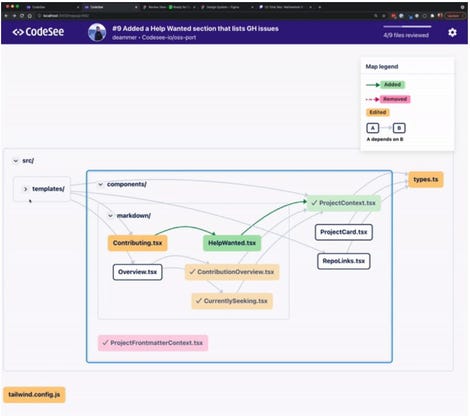
CodeSee adds map visualization to its code production platform
[ad_1]
As newer, heavier software applications loaded with new functionality — think “AI” — keep rolling into the market, more and more complicated codebases ride with them into the cloud and our devices.
As those codebases become denser, more sophisticated tools are needed for developers to understand and navigate them. That’s where newcomer CodeSee comes into the picture.
The San Francisco-based startup, which claims to be the first solution to offer developers a continuous understanding of large codebases, today introduced a new feature for its platform called Review Maps. Using this visualization tool, developers can contextualize the potential impact of code changes, address feedback, and submit reviews — all in one session.
Why is this relevant?
CodeSee aims to help enterprises solve a major problem prevalent with these ever-growing codebases and growing requirements for accelerated delivery: a lack of shared understanding of how all the code and functionality map to each other. This problem is especially acute with geographically separated dev teams. With its new ability to generate codebase maps and update them in real time when changes are made, CodeSee provides an accurate source of code truth so that everyone is operating from the same model and can move faster and smarter, CEO Shanea Leven told ZDNet.
“It’s simple to get started,” Leven said. “Basically, we hook right into your repository, so you can actually get started in about 10 clicks. Your first map, depending on how big your codebase is, will take anywhere from a few microseconds to maybe two minutes or so to generate.
“It looks simple, but it’s really complex in its simplicity. The first part is auto-generated, so a developer doesn’t actually have to know how the code works in their minds anymore. They don’t have to draw this themselves; it’s auto-generated, but it’s also auto-updated. And so whenever new code changes happen, this map will automatically update itself.”

CodeSee adds visualization maps to make development projects easier to complete.
Performing code reviews to ensure the quality of delivered software is a common best practice among proprietary and open source development teams. An empirical study on the impact of modern code review practices on software quality is evidence that code reviews matter.
Developers often encounter reviews that aren’t thorough or offer feedback that is difficult to understand or unactionable. As a consequence, many miss out on opportunities to learn, share knowledge, and raise the quality of shipped code, Leven said.
How it serves as a sanity check
For code authors, the tool becomes a sanity check, enabling them to account for deleted files, edge cases, tests, and other elements. Code reviewers can visualize a change and understand what they are reviewing; they can quickly grasp how significant the change is and whether it’s isolated or may impact multiple areas of the codebase.
Key CodeSee features include side-by-side code comparison, intuitive grouping (code is grouped so users can review based on logic and functionality); identifying dependencies; adding comments (users provide feedback on code reviews by placing and responding to Comments — they’re automatically reflected in the GitHub repository); a progress bar (users mark sections as “reviewed” as they move through a code review); and a Submit Code Reviews feature, in which users contextualize and submit code reviews, all in one UI/UX.
In September, the company announced both a seed funding round of $3 million and the beta release of OSS Port, which enables open-source contributors and maintainers to more easily integrate, quickly understand, and work with new codebases. Cloud-native leaders LaunchDarkly and Snyk were prominent angel investors in this round.
[ad_2]
Source link




